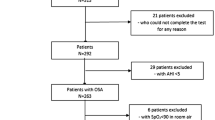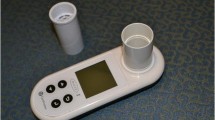Abstract
The aim of this study was to study the prevalence of obstructive sleep apnea syndrome in patients with nasal and nasopharyngeal pathologies. A total of 60 consenting patients between the age of 14 to 60 years with primary nasal and nasopharyngeal pathologies were taken up for the study. These patients underwent history taking, detailed clinical examination including BMI, diagnostic nasal endoscopy and overnight polysomnography. The polysomnography results of people with different pathologies were compared and analysed. Based on the analysis it was arrived that isolated pathologies like septal deviation, nasal polypi and adenoid hypertrophy provided a statistically significant association with occurrence and severity of OSA. Also, that patients with combined pathologies were more proportionately affected by OSA than those with isolated pathologies. Nasal and nasopharyngeal pathologies have significant association with obstructive sleep apnea syndrome and all patients with these pathologies need to undergo polysomnography along with other routine investigations.


Similar content being viewed by others
References
Friedman’s sleep apnea and snoring: surgical and non-surgical therapy Chap. 2 pg. 3
Ballenger’s textbook of Otolaryngology Chap. 98, pg. 1279–1282
Friedman’s sleep apnea And snoring: surgical and non-surgical therapy chap. 2 pg. 4,5,6,7.
Scott-Brown’s Otorhinolaryngology Head & Neck surgery; 8th edition, volume 3, Chap. 73
Cummings textbook of Otorhinolaryngology 7th edition, Chap. 15
Ganong’s medical physiology 26th edition, Chap. 14
Obstructive sleep apnea Diagnosis and treatment. Clete A Kushida. Chapter 4, pg61–63
Mannarino MR, Di Filippo F, Pirro M (2012) Obstructive sleep apnea syndrome. Eur J Intern Med 23(7):586–593
Scott brown 8th edition, volume 1, Chap. 103, page 1137
Mladina R (1987) The role of maxillar morphology in the development of pathological septal deformities. Rhinology 25(3):199–205
Huizing EZ, de Groot JAM, Sect. (2003) 8: Surgery of the Nasal Cavity: Turbinate Surgery. Functional Reconstructive Nasal Surgery, 2nd edition, Thieme, Stuttgart, pg. 276–282
Meltzer EO, Hamilos DL, Hadley JA, Lanza DC, Marple BF, Nicklas RA et al (2006) Rhinosinusitis Initiative. Rhinosinusitis: develo** guidance for clinical trials. J Allergy Clin Immunol 118(5 Suppl):S17–61
Lin CM, Davidson TM, Ancoli-Israel S (2008) Gender differences in obstructive sleep apnea and treatment implications. Sleep Med Rev 12(6):481–496
Deng X, Gu W, Li Y, Liu M, Li Y, Gao X (2014) Age-group-specific associations between the severity of obstructive sleep apnea and relevant risk factors in male and female patients. PLoS ONE 9(9):e107380
Georgalas C (2011) The role of the nose in snoring and obstructive sleep apnoea: an update. Eur Arch Otorhinolaryngol 268(9):1365–1373
Yeom SW, Kim MG, Lee EJ, Chung SK, Kim DH, Noh SJ, Lee MH, Yang YN, Lee CM, Kim JS (2021) Association between septal deviation and OSA diagnoses: a nationwide 9-year follow-up cohort study. J Clin Sleep Med 17(10):2099–2106
Lavie P, Fischel N, Zomer J, Eliaschar I (1983) The effects of partial and complete mechanical occlusion of the nasal passages on Sleep structure and breathing in Sleep. Acta Otolaryngol 95(1–4):161–166
Patel B, Virk JS, Randhawa PS, Andrews PJ (2018) The internal nasal valve: a validated grading system and operative guide. Eur Arch Otorhinolaryngol 275(11):2739–2744
Lenders H, Schaefer J, Pirsig W (1991) Turbinate hypertrophy in habitual snorers and patients with obstructive sleep apnea: findings of acoustic rhinometry. Laryngoscope 101(6 Pt 1):614–618
Michels Dde S, Rodrigues Ada M, Nakanishi M, Sampaio AL, Venosa AR (2014) Nasal involvement in obstructive sleep apnea syndrome. Int J Otolaryngol. ; 2014:717419
Migueis DP, Lacerda GCB, Lopes MC, Azevedo-Soster LMSF, Thuler LCS, Lemes LNA, Araujo-Melo MH (2019) Obstructive sleep apnea in patients with chronic rhinosinusitis with nasal polyps: a cross-sectional study. Sleep Med 64:43–47
Kang KT, Chou CH, Weng WC, Lee PL, Hsu WC (2013) Associations between adenotonsillar hypertrophy, age, and obesity in children with obstructive sleep apnea. PLoS ONE 8(10):e78666
Talukder Dc1, Aich Ml2, Alam Mr3, Islam Ms4, Mahmud S5, Biswas D6, Saha K7, Rahman F8. Associations between adenotonsillar hypertrophy, age, and obesity in children with obstructive sleep apnea J Dhaka Med Coll (2017) ; 26(2): 167–172
Magliulo G, Iannella G, Ciofalo A, Polimeni A, De Vincentiis M, Pasquariello B, Montevecchi F, Vicini C (2019) Nasal pathologies in patients with obstructive sleep apnoea. Acta Otorhinolaryngol Ital 39(4):250–256
Wu J, Zhao G, Li Y, Zang H, Wang T, Wang D, Han D (2017) Apnea-hypopnea index decreased significantly after nasal surgery for obstructive sleep apnea: a meta-analysis. Med (Baltim) 96(5):e6008
Svanborg E, Guilleminault C (1996) EEG frequency changes during sleep apneas. Sleep 19(3):248–254
Funding
The authors did not receive support from any organization for the submitted work. Financial interests: The authors declare they have no financial interests. Non-financial interests: none.
Author information
Authors and Affiliations
Contributions
All authors contributed to the study conception and design. Material preparation, data collection and analysis were performed by Dr. B. Shankameswaran and Dr. G. Viveknarayan. The first draft of the manuscript was written by Dr. B. Shankameswaran and all authors commented on previous versions of the manuscript. All authors read and approved the final manuscript.
Corresponding author
Ethics declarations
Ethical Approval
Institutional ethical committee approval was obtained and the study was performed in accordance with the ethical standards as laid down in the 1964 Declaration of Helsinki and its later amendments or comparable ethical standards.
Consent
Informed consent was obtained from the patients before the study.
Competing Interests
The authors have no competing interests to declare that are relevant to the content of this article.
Additional information
Publisher’s Note
Springer Nature remains neutral with regard to jurisdictional claims in published maps and institutional affiliations.
Rights and permissions
Springer Nature or its licensor (e.g. a society or other partner) holds exclusive rights to this article under a publishing agreement with the author(s) or other rightsholder(s); author self-archiving of the accepted manuscript version of this article is solely governed by the terms of such publishing agreement and applicable law.
About this article
Cite this article
Shankameswaran, B., Viveknarayan, G., Gowrishankar, M. et al. Prevalence of Obstructive Sleep Apnoea in patients with primary nasal and nasopharyngeal pathologies. Indian J Otolaryngol Head Neck Surg (2024). https://doi.org/10.1007/s12070-024-04742-4
Received:
Accepted:
Published:
DOI: https://doi.org/10.1007/s12070-024-04742-4




